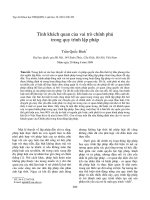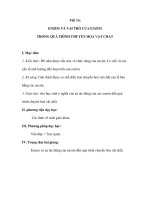Chuyên viên quảng cáo (IMC) - Chương 2: Vai trò của IMC trong quy trình marketing
Bạn đang xem bản rút gọn của tài liệu. Xem và tải ngay bản đầy đủ của tài liệu tại đây (1.55 MB, 25 trang )
2
The Role of IMC in the
Marketing Process
The Role of IMC in the
Marketing Process
2
McGraw-Hill/Irwin
© 2004 The McGraw-Hill Companies, Inc., All Rights Reserved.
Marketing and Promotions Process Model
Competitive
analysis
Target
marketing
Identifying
markets
Market
segmentation
Selecting
a target
market
Positioning
through
marketing
strategies
Product
decisions
Pricing
decisions
Channel of
distribution
decisions
Promotional
decisions
•advertising
•direct
marketing
•internet/
interactive
marketing
•sales
promotion
•publicity
and public
relations
•personal
selling
Resellers
Ultimate
customer
•Consumers
•Businesses
Promotion to
final buyer
Target Market
Purchase
Promotion
to trade
Marketing
Strategy and
Analysis
Target
Marketing
Process
Marketing Planning
Program Development
The Target Marketing Process
Identify markets with unfulfilled needs
Identify markets with unfulfilled needs
Determining market segmentation
Determining market segmentation
Selecting market to target
Selecting market to target
Positioning through marketing strategies
Positioning through marketing strategies
Five-Step Segmentation Process
1. Finding ways to group consumers
according to their needs.
2. Finding ways to group marketing actions,
usually the products offered, available to
the organization.
3. Developing a market/product grid to
relate the market segments to the firm’s
products and actions.
4. Selecting the product segments toward
which the firm directs its marketing
actions.
5. Taking marketing actions to reach target
segments.
Bases for Segmentation
• Geographic Segmentation
– State - region - country - climate
• Demographic Segmentation
– Age, sex, income, education, occupation,
social class
• Psychographic Segmentation
– AIOs, (Activities, Interests, Opinions)
– VALS (Values and Lifestyles)
– Personality traits
• Behavioristic Segmentation
– Usage, loyalties, occasions.
• Benefit Segmentation
– Types of specific needs or wants to be
satisfied
.
Selecting a Target Market
Determining How Many Segments To Enter
¾ Undifferentiated Marketing – offering one product or
service to the entire market
¾ Differentiated marketing – competing in a number of
segments with separate marketing strategies for each
¾ Concentrated Marketing – focusing on one market
segment
Determining Which Market Segments
Offer the Most Potential
¾ Determine sales potential of the segment
¾ Determine opportunities for growth of the
market segment
¾ Analyze the competition in the segment
¾ Analyze the company’s ability to compete in
the market segment
¾ Decide how to compete in the market segment
Segmentation Decision Check List
¾ Can the size of the market
segment be measured?
¾ Is the market segment large and
profitable enough to serve?
¾ Is the segment identified
accessible? Can it be reached
effectively and efficiently?
¾ Can effective marketing programs
be developed to attract and serve
the segment identified?
The Positioning Process
Positioning Concept
The desired perception or
association management wants
target customers to have for a
firm and/or its products
Positioning Effectiveness
The extent to which management’s
positioning objectives are achieved
in the market target
Positioning Strategy
The combination of marketing
actions used to portray the
positioning concept to targeted
buyers
Positioning of the brand
The positioning of the brand by
the buyers in the market target
Market
Target
JetBlue Airways positions itself as a low price
airline with great service









